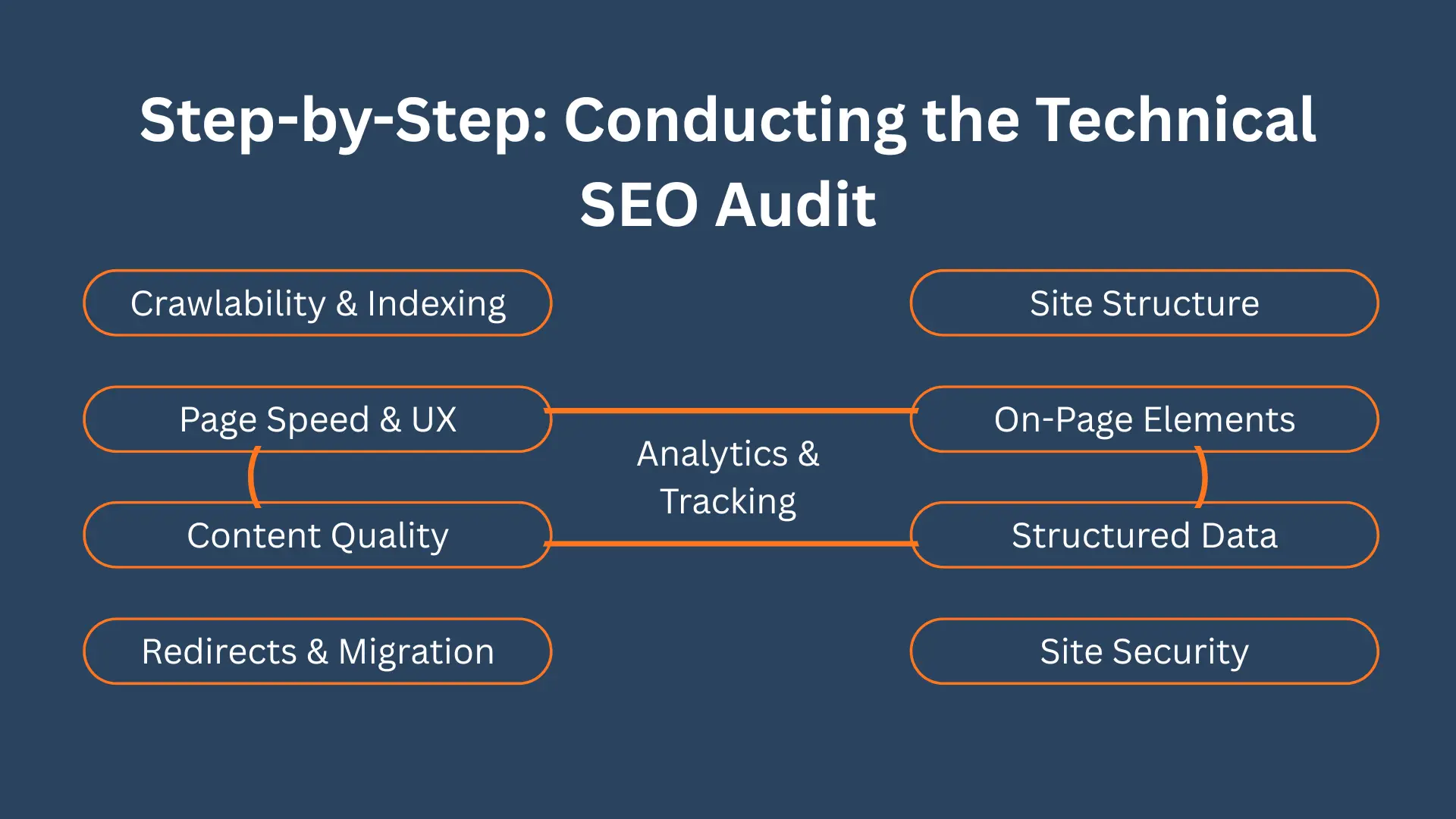Technical SEO Audit to Fix Ranking Issues Fast in 2025
Your website might look perfect on the surface. Your website looks amazing, it loads fast, the visuals grab attention, and your blog posts are solid. Still, somehow, your rankings refuse to move up.
That’s where a technical SEO audit steps in.
Just like a health check for your website’s inner systems. It’s like when your car seems okay but keeps stalling for no reason. For that, a technical SEO audit is the best option that helps with. It digs into your site’s setup, speed, and performance to figure out what’s holding it back.
And here’s the best part: fixing technical issues often brings faster ranking improvements than rewriting content. And SEO audit tools, and how to know when it’s time to bring in one of the best SEO Services in the USA that actually deliver.
So if you want real results, start here.
Why a Technical SEO Audit Matters?
Search engines love efficiency. They want to crawl, understand, and index websites easily. If your site makes that process hard, it won’t matter how great your content is; your rankings will drop.
A technical SEO audit helps you identify hidden problems. It spots crawl errors, duplicate pages, and slow load times. Even a messy structures that confuse both bots and users.
Here’s why it matters:
- To improve crawlability and indexation, allowing search engines to reach all your important pages.
- It enhances user experience, which now plays a huge role in rankings.
- This makes sure your site stays healthy through regular SEO health checks.
And most importantly, it helps you recover or protect rankings during SEO migration or redesigns.
Ignoring these issues can cost you visibility, conversions, and credibility. But the good news? A proper audit gives you control again, fast.
Setting Up for Your Audit: Tools & Prep
Before you begin, you need the right setup. Without preparation, audits can feel challenging. Start with these simple steps:
- Access your essentials: Make sure you have full access to Google Search Console, Google Analytics (or GA4), and your website’s backend.
- Back up your site: Always create a backup before making changes. You’ll thank yourself later.
- List your target pages: Note your most important URLs, homepage, landing pages, product or service pages. These will guide your audit focus.
- Benchmark your metrics: Record your current rankings, load speed, and crawl stats. After the audit, you’ll want to compare improvements.
Now, grab a few SEO audit tools. The most trusted ones include:
- Screaming Frog or Sitebulb for crawling.
- Google PageSpeed Insights for speed and Core Web Vitals.
- Ahrefs, SEMrush, or Moz for overall SEO site audit and technical insights.
- SEO optimization checker tools for quick reports on missing tags or errors.
Once everything is ready, you can confidently start the audit.

Step-by-Step: Conducting the Technical SEO Audit
A structured process keeps things smooth and efficient. Let’s go step by step, focusing on key technical factors that directly impact performance.
Step 1: Crawlability & Indexation
Crawlability is how well search engines can discover your content. Start by running a crawl with Screaming Frog or another SEO audit tool. Check these:
- Robots.txt file: Ensure it doesn’t block important areas. For example, avoid this:
- Disallow: /blog/, if you want your blog posts to appear in Google results.
- Sitemap.xml: Keep it updated and submitted to Google Search Console.
- Noindex tags: Make sure only low-value pages (like admin or thank-you pages) are excluded.
- Broken links and 404 errors: These waste crawl budget and frustrate users.
After the crawl, look for pages that aren’t indexed.
If they’re valuable, find out why. Sometimes, canonical tags or redirects cause conflicts. Fixing these issues ensures Google sees your full site structure, not just part of it.
Step 2: Site Architecture, URL Structure & Navigation
A well-organized site helps both users and bots. When your structure is logical, search engines can follow paths easily. Check these areas:
- Click depth: Important pages should be within three clicks from the homepage.
- Internal links: Use contextual linking to connect related pages.
- Navigation menu: Keep it simple and descriptive.
- URLs: Keep them short, keyword-rich, and consistent. Avoid numbers or random strings.
For instance,
“ https://example.com/technical-seo-audit-guide” instead of “https://example.com/page?id=5678”
“https://example.com/blog/seo-health-check-tips” instead of “https://example.com/blog/article123”
“https://example.com/services/seo-migration-support” instead of “https://example.com/services.php?cat=seo”
A clean structure improves crawlability and user trust. Plus, it makes future SEO migration much easier.
Step 3: Page Speed, Mobile Usability & Core Web Vitals
People don’t wait; neither does Google. If your site loads slowly, your bounce rate skyrockets. Run PageSpeed Insights or Lighthouse to check:
- LCP (Largest Contentful Paint)
- CLS (Cumulative Layout Shift)
- INP (Interaction to Next Paint)
Aim for quick load times on both mobile and desktop. Compress images, enable caching, and use a CDN. Next, check mobile usability. Over 60% of searches come from mobile devices.
Ensure your design is responsive, fonts are readable, and buttons are clickable. A smooth mobile experience boosts engagement and rankings.
Step 4: On-Page Technical Elements
These details seem small, but they impact how search engines read your pages. Review:
- Title tags and meta descriptions: Each page needs unique, descriptive metadata.
- Header tags (H1, H2, H3): Maintain a logical hierarchy with your keywords naturally included.
- Structured markup: Add schema where appropriate, FAQ, Article, Product, etc.
- Alt text for images: Describe images using relevant keywords.
- Canonical tags: Avoid duplicate content confusion.
Tools like an SEO optimization checker quickly highlight missing or duplicate tags. Fixing these helps both users and search engines understand your content better.
Step 5: Content Indexation, Duplicate Content & Thin Pages
Now it’s time to clean up your content layer. Use a crawler to find:
- Duplicate pages caused by parameters or session IDs.
- Thin content with fewer than 300 words or little value.
- Low-traffic pages that don’t serve a clear purpose.
Decide what to do:
- Merge similar pages.
- Add depth and originality to thin content.
- Use “noindex” for low-value pages.
- Removing or fixing these pages helps Google focus on your most important content.
It’s like decluttering; your site becomes easier to understand, and ranking improves faster.
Step 6: Structured Data & Rich Results
Structured data is your secret weapon for standing out in search results. It helps search engines understand context, who you are, what you offer, and why your page matters.
Use Google’s Rich Results Test to see what schema is active. Common types include:
- Organization
- Breadcrumb
- Article
- Product
- FAQ
If you spot warnings, fix them right away. Adding proper schema improves visibility and can boost click-through rates significantly.
Step 7: Redirects & Migration Issues
Redirects can either protect or destroy your SEO. If you’ve changed URLs or migrated platforms, check for:
- Redirect chains (multiple redirects in a row). Example: “Page A → Page B → Page C”
- Redirect Loops (redirects that never end). Example “Page A → Page B → Page A, “a never-ending cycle that blocks both users and crawlers.
- Incorrect 302s (temporary redirects used instead of 301s).
- Broken links that point to removed pages.
- During the SEO migration, map all old URLs to their corresponding new ones before launch.
- Afterward, test thoroughly using tools like Screaming Frog.
Fixing these early prevents ranking drops and preserves link equity.
Step 8: Security, HTTPS & Server/Hosting Issues
Google prefers secure sites, and so do users. Check your SSL certificate and ensure your entire site runs on HTTPS.
Next, review your hosting:
- Does your server respond quickly?
- Are there frequent downtime issues?
- Is your hosting location close to your target audience?
Even minor hosting delays can hurt performance metrics. Invest in reliable hosting or a CDN to boost speed and stability. Security isn’t just technical; it’s trust-building.
Step 9: Analytics, Tracking & KPI Benchmarking
You can’t improve what you don’t measure. Set up analytics properly before, during, and after the audit. Ensure the following points:
- Google Analytics tracks conversions, sessions, and user behavior.
- Google Search Console records impressions, clicks, and indexing stats.
- KPIs are clear: organic traffic, rankings, and engagement metrics.
- Use these benchmarks to measure the improvement after implementing the fixes.
You’ll see patterns, faster indexing, higher CTR, and better rankings, which prove that your technical audit was successful.

How To Choose The Best USA SEO Services That Actually Deliver Technical Fixes
Not every SEO agency understands the technical side. Many focus only on keywords or backlinks.
When selecting an SEO partner, look for one that provides technical SEO audits as part of their core service.
Here’s what to check:
- Experience: Have they handled audits for businesses of your size?
- Transparency: Do they share detailed reports and action plans?
- Toolset: What SEO audit tools do they use?
- Case studies: Ask for proof of ranking recovery or SEO migration success.
- Support: Do they provide ongoing SEO health checks after the audit?
Choose wisely, the Top SEO Services in USA That Actually Deliver won’t just fix your issues; they’ll future-proof your site.
When to Call in the Experts: SEO Services in the USA That Actually Deliver
Sometimes, even with the best tools, a full audit feels too complex.
That’s when calling in professionals makes sense.
Technical SEO experts can:
- Diagnose deep structural issues you might miss.
- Handle advanced SEO migration tasks safely.
- Offer faster implementation with fewer trials and errors.
- Monitor your site post-fix to prevent regressions.
- If your traffic dropped suddenly or a site redesign caused chaos, don’t panic.
Contact a Guest Posting Solution, known for its technical precision and proven results, for best SEO services in the USA that actually deliver. They will guide you through every fix.
Conclusion
Running a technical SEO audit may sound intimidating, but it’s one of the smartest investments you can make for your website.
Each fix, faster loading time, cleaner structure, and secure pages move you closer to better visibility and stronger trust.
- Remember, SEO isn’t just about keywords or backlinks.
- It’s about creating a site that works perfectly, inside and out.
- Start your audit today.
- Utilize reliable SEO audit tools, monitor performance, and take prompt action.
And if you ever feel stuck, reach out to experts who truly understand the craft, because solid technical SEO is the foundation of every lasting online success.
FAQs
1. How does an SEO audit help to improve ranking?
It finds hidden technical issues that block search engines or hurt user experience. Once fixed, your site becomes easier to crawl and rank.
2. How often should you perform an SEO health check?
At least once every quarter. Regular audits keep your site clean, prevent ranking drops, and prepare you for algorithm updates.
3. When is an SEO migration support required?
Whenever you change domains, CMS, or structure. Expert SEO migration support ensures your rankings don’t crash during the transition.
4. How much should a technical SEO audit cost?
Costs vary. A basic site audit costs differently, while large or complex sites can be more than that. What matters most is the value, not just the price, since a good audit can recover far more in lost traffic.






